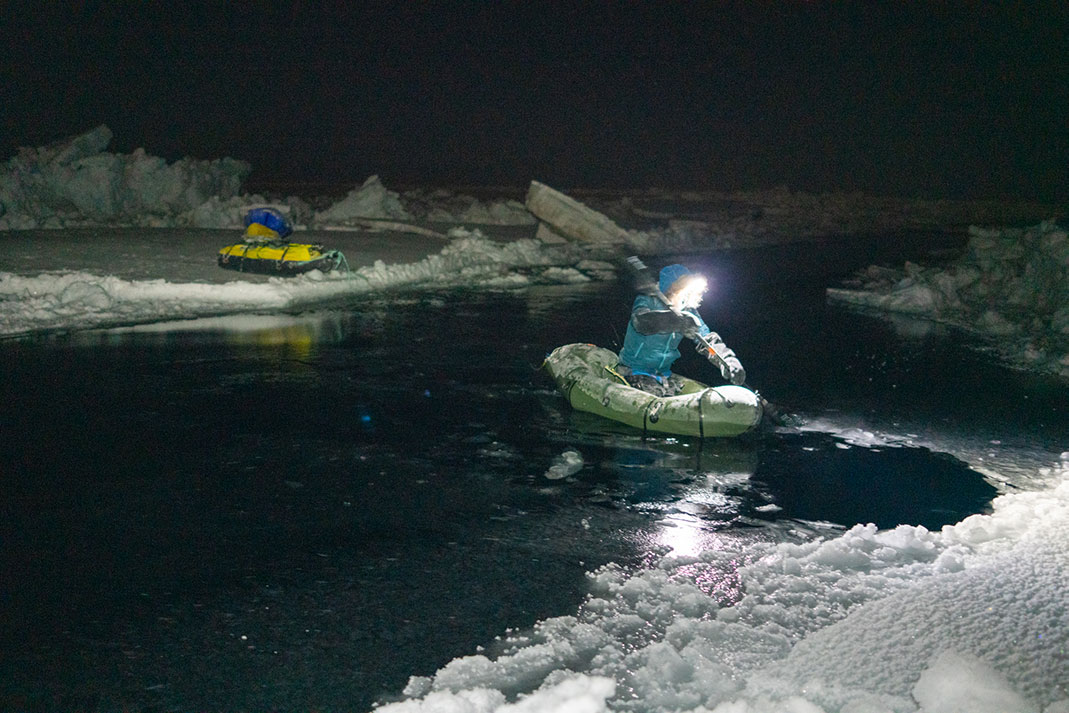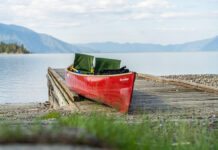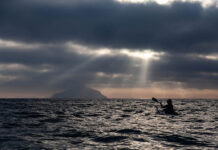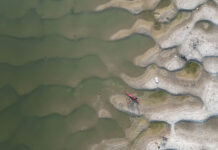As sea ice melts and weather patterns become drastically altered, adapting to the whims of climate change has become a necessity of life in polar regions and for the adventurers who test their limits in these capricious places. Since completing his first North Pole trip in 1990, Norwegian explorer Børge Ousland has observed the changes in real time, including a 30 percent decrease in ice coverage in the Arctic Ocean and a corresponding reduction in ice thickness from 10 to 12 feet to barely six.
On one hand, sketchy ice imposes serious safety hazards for those who are inclined to ski to the North Pole. On the other, melting conditions inspired a 2019 journey by Ousland and South African adventurer Mike Horn heralded as “the boldest polar expedition of modern times.”
Ousland describes the expedition as “a classical polar trip.” Like Roald Amundsen, the pioneering Norwegian polar explorer he’s been compared to, the 57-year-old Ousland endeavored to access the icecap by boat. Horn conceived the plan: Setting off from Alaska aboard Horn’s 105-foot Pangaea, the pair would sail north, before skiing unsupported for 12 weeks over the pole, ultimately meeting the sailboat on the Norwegian side of the globe to finish their trip.
The expedition was timed for autumn for the least ice coverage, to enable the Pangaea to penetrate as far north as possible; typical North Pole bids are made in March and April when the ice is thickest and daylight returns. Ousland and Horn would ski into the complete darkness of Arctic winter.
On September 11, Pangaea was thwarted by ice at 85.3 degrees north, establishing a new record. Before stepping into their bindings and setting off on a 1,000-mile ski with 410-pound sleds in tow, Ousland and Horn each inflated an Alpacka Yak packraft. Thirty years ago, Ousland would never imagine traveling across the polar north with a raft and paddle strapped to his sled. He got the idea after using packrafts on a summer trip on Alaska’s Stikine River in 2015. The alternative strategy to crossing expanses of frigid open water in the sea ice is to swim, but “that would take too much time and energy,” Ousland says.
Typically used for amphibious summertime journeys, packrafts had never been used for an Arctic expedition like this. Ousland tested his raft by leaving it for a weekend at an Oslo ice cream factory. The fabric survived the deep freeze, convincing the adventurer these lightweight, doughnut-shaped boats could serve as life rafts in the -40ºF temperatures.
The bulk of their load consisted of 85 days of provisions, with the intention of ramping up their caloric intake from 5,000 calories per day to 6,000 by the journey’s end. This meant covering 11 miles per day—a target that became an immediate challenge as ice conditions were even more precarious than anticipated. Aboard their packrafts, Ousland and Horn used ski poles to skim over areas of thin, clear ice that might’ve buckled under a skier’s weight. They paddled across leads of open water, ribbons of 4,000-foot-deep seawater up to 400 yards wide and 40 miles long.
Each water crossing meant removing their packrafts from their sled, climbing into the cockpit and gingerly paddling across, with the oversized, waterproof and buoyant sleds jerking and dragging behind them, threatening their stability. If that image isn’t terrifying enough, it’s mind-blowing to consider doing this in complete darkness (the pair packed 22 pounds of batteries for their headlamps).
“We got used to it, but we never really liked it, knowing that water was the most dangerous thing and it is so easy to have an accident.”
“We got used to it, but we never really liked it, knowing that water was the most dangerous thing and it is so easy to have an accident,” Ousland recalls. “We were sitting on our knees in the rafts when paddling, so we were quite top-heavy, and we had a couple of near misses where we easily could have toppled.”
Scouting the ice and getting in and out of the rafts slowed Ousland and Horn’s progress considerably. What’s more, the pair’s estimated daily mileage banked on favorable drift from ocean currents, which normally flow from the Pacific to the Atlantic side—and have been employed by polar explorers since the 1800s. However, Ousland and Horn encountered an opposing current, likely on account of the thinner ice being more subject to winds than currents. As a result, the pair struggled to make five miles per day through October. It took them 36 days to reach the North Pole.
The situation became desperate when Horn’s frostbitten fingers became badly infected and barely usable. The pair lost a soul-crushing 28 miles of headway due to wind drift in a blizzard on November 14. With less than two weeks of food remaining, expedition manager Lars Ebbesen made a satellite phone call to implore the pair to accept rescue from a passing icebreaker. At such a dark and hostile time of year, Ebbesen reminded them it was their only chance to bail out. Newspapers in Norway and around Europe tracking the expedition speculated on Ousland’s plight. But the iconic explorer was resolute. He told Ebbesen, “No, we will continue.”
On Day 77, with 200 miles to go, Ousland created a new measurement of time: the 30-hour day. Facing exhaustion, the pair somehow managed a string of 20-mile days. Meanwhile, Pangaea faced its own ice challenges in its efforts to reposition itself to meet the skiers on the Norwegian side of the globe; the Lance, a heavy-duty icebreaker, was summoned by Ebbersen to intercept them.

Ousland and Horn caught a joyous glimpse of the Lance’s lights on the dark horizon on Day 86. Shortly after that, so close to success, Horn broke through thin ice—his awkward fall and desperate kicks to escape the frigid water captured in a haunting video by Ousland’s low-light camera. Ousland pitched camp hastily and Horn rewarmed over a camp stove in the tent. Later, Horn admitted to feeling “emptied of emotions…[like] I’d just survived something I shouldn’t have survived.” Yet, barely a few hours later, they were on the move again, launching the packrafts to cross one last span of open water.
Ousland and Horn reached the Lance on December 7, marking the first successful North Pole crossing with boat access on both ends. Each man had lost over 20 pounds.
Weeks later, Ousland was awarded the 2019 Adventurer of the Year—and he announced this would be his last long polar expedition. No doubt, the changing Arctic will require the next generation of adventurers to adopt creative solutions to probe its depths, Ousland says. “I am pleased to learn that I still could do it and that I could take the cold,” he adds. “It’s hard to say if this trip will be possible in the future.”
 This article was first published in Paddling Magazine Issue 63. Subscribe to Paddling Magazine’s print and digital editions here, or browse the digital archives here.
This article was first published in Paddling Magazine Issue 63. Subscribe to Paddling Magazine’s print and digital editions here, or browse the digital archives here.
Less than halfway through the trip, the men entered the Arctic winter and trekked through perpetual darkness, with only their headlamps and the moon offering any light. | Photo: Borge Ousland








